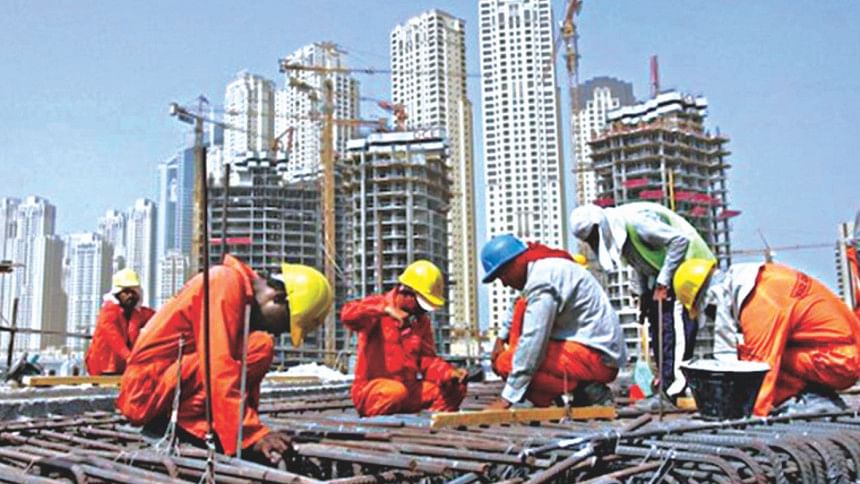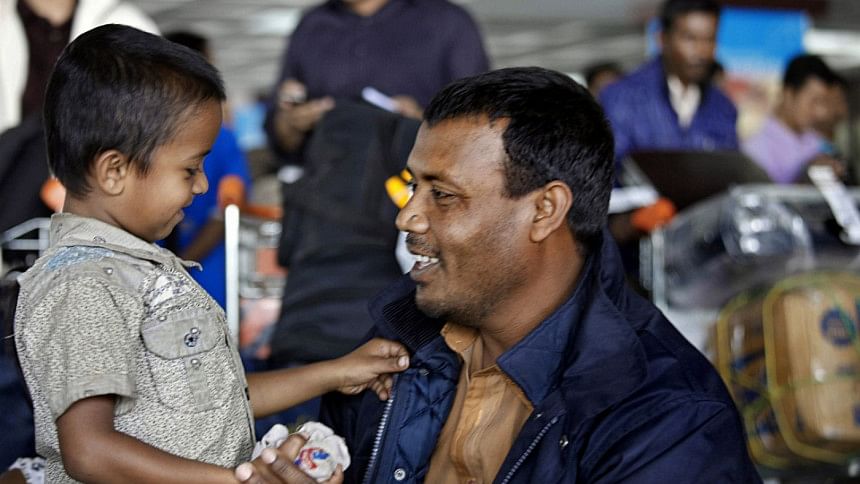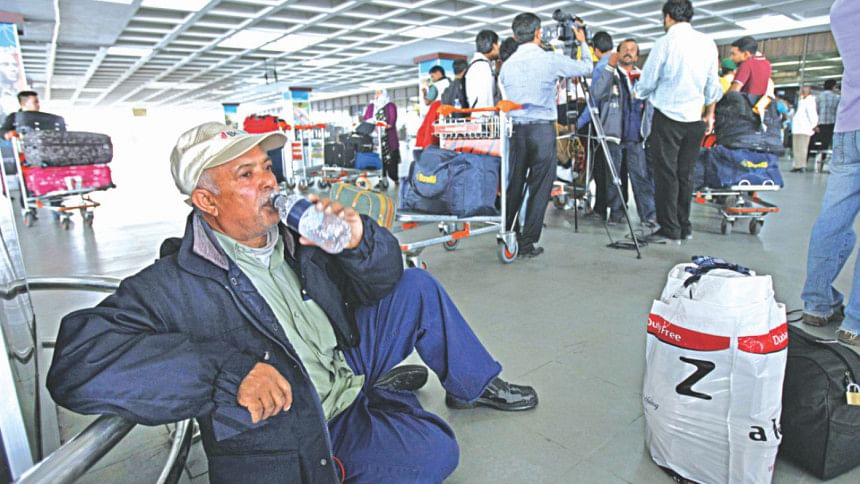Untold stories of Bangladeshi migrant workers

Bangladesh is a labour surplus country. Each year, around 2 million Bangladeshi youth join the labour force while about 200,000 new workers are absorbed into the formal sector. The rest find jobs in the informal sector or become self-employed. A large section of them remain unemployed and underemployed. The other well-known option available to Bangladeshi youth is to participate in the international short-term contract labour market in the Gulf and other Arab and South East Asian countries. Some questions I would like to discuss in this article are: what are the other major drivers of migration from Bangladesh, along with this national employment scenario? Under what circumstances do men and women from Bangladesh decide to migrate? How do they process their migration, what type of employment do they take up and what type of work and living conditions do they experience in their destination countries?
WHY THEY MIGRATE
Nizam Uddin is from Satkhira. Due to the cultivation of shrimp by farmers next to his land, he could no longer produce crops on his land. In 2009 cyclone Aila destroyed his home. Since then another problem he has had to face is water-logging. He has to provide for a family of five that includes his mother, wife and two children. He desperately needed employment. His cousin in Dhaka informed him about an opportunity to migrate to Qatar if he could arrange Tk. 300,000. Nizam Uddin arranged the amount mostly from his in-laws, a few other relatives and took loans from money lenders and migrated to Qatar in 2014.
Jamila from Tangail is married with two children. Due to his ill temperament her husband cannot retain his job. With the help of her uncle Jamila and her husband managed to migrate to Gazipur to work in a garment's factory leaving their two children behind. But Jamila's husband was again unable to keep his job. At one point her husband went back to the village. For quite a few years Jamila was managing her children's education and household expenditure with her income. It was at this stage that she and her friend were approached by her uncle's friend Majid dalal to work in a garment's factory in Jordan. Jamila decided to migrate even though her husband was not in favour of the idea. She spent about Tk. 40,000 to migrate there.
Intas Ali of Shariatpur was hardly 19 and a school drop-out. His father was anxious about his future because Intas was mixing with the wrong crowd. Intas developed a relationship with a girl from Ishwardi. At one stage he eloped with the girl. The girl's family tracked them down and took their daughter back with them. They also filed a case against Intas accusing him of abducting an underage girl. Intas was forced to go into hiding. His father, finding no other way out, sent Intas to Oman with the help of his nephew who was working
there. The nephew bought a work visa for Intas Ali and his father processed the visa through a local dalal
These three stories tell us why people like Nizam, Jamila and Intas migrate abroad.
Migration is multi-causal. It depends on micro level factors such as individual and household characteristics interplaying with macro level economic, demographic, political and environmental factors. It also depends on meso level factors such as policies and institutions of the government, social network of the migrant and operation of dalals and recruiting agencies.

In the case of Nizam Uddin, cyclone Aila is the environmental event, salt water intrusion in his agricultural field is an outcome of the government policy of encouraging shrimp cultivation, his micro reality of desperate need for income and job, his cousin working in Dhaka, and his capacity to extract or extort money from his in-laws being his social capital, all cumulatively resulted in his migration. For Jamila, the main catalytic factor was her individual and household need for income, her personal desire and agency to change her future through migration first to Dhaka and then to Jordan, her access to family network and informal recruitment network created the scope for migration. Integration of global economy, feminisation of the workforce in the manufacturing sector and development of fee charging agencies in Jordan helped Jamila participate in the labour market of the integrated global economy. Her migration decision is not only hers. It is the outcome of an interplay of individual, national and global economics.
Intas Ali's case shows migration is not only an individual's decision, it is a household strategy. In his case economic factors were not the main driving force. It was the social factor that led his household to decide in favour of his migration. The immediate goal of the household was to protect Intas Ali from going to jail and ultimately to get him away from his immediate surroundings and help him build a better future.
In 2018, 7,34,000 Bangladeshis migrated for short-term employment. Thirteen percent of them were women. All of them have similar stories of what led them to migrate.
It is easy to dream that migration would yield a better future. However, processing migration is an extremely difficult task. Everyone is not as lucky as Intas Ali, Jamila and Nizamuddin. A recent survey of 5,407 household of RMMRU and Prokas found that 19 percent of those who wanted to migrate could not do so even after paying on average of Tk. 200,000. They were cheated while processing migration by neighbours, dalals and unscrupulous recruiting agencies.
Mojnu Sikader from Tangail knew Malek Mia for years. When he decided to migrate, he got in touch with Malek Mia and a few others who are in this business of facilitating migration. In 2016 Mojnu gave all necessary documents including his passport and paid Tk. 130,000 through BRAC Bank to Malek who promised him a job in the construction sector in Malaysia.
Malek took Mojnu Mia to Dhaka on three occasions; once for registration and finger printing at BMET, another time to face an interview with a recruiting agency and again to conduct medical tests. All costs of those trips were borne by Mojnu Mia, in addition to his migration cost. Later on, the dalal informed him that all his formalities for migration were complete and that his flight would be on the following week. Trusting what the dalal said, Mojnu paid the outstanding amount of his migration cost.
Having bid goodbye to his family Mojnu went to the airport on the stipulated date. To his utter surprise the airport authority denied him from boarding the flight. Mojnu was informed that he was travelling on a fake visa. The experience devastated him. Since then he has been unable to trace the dalal Malek Mia.

In 2015 Rashedul gave dalal Abdul Mannan Tk. 4,45,000 along with his passport to go to Iraq. Instead of sending him to Iraq the dalal sent him to Malaysia after making him wait for two years. His is a case of irregular migration where Rashedul was flown to Indonesia and was detained there for eight days. Later he was allowed to proceed to Malaysia. Rashedul thought all his worries would be over once he reached his destination.
In Malaysia his dalal's counterpart took him from the airport and instead of giving him a job confined him for 12 days. They tortured him and forced him to arrange a payment of Tk. 3,80,000 from his family. Once the gang received the money they let him go. Unfortunately, within 12 days, Rashedul was apprehended by the Malaysian police and jailed for a year. After he served his sentence, he secured an air-ticket with the help of his family and returned to Bangladesh.
The RMMRU and Prokas survey found that 49 percent of migrants had successfully migrated abroad and gained employed. The sectors of employment were different for male and female migrants.
The 2017 panel survey of SDC and RMMRU showed that 32 percent of the male workers were employed in the service sector, and another 24 percent in the construction sector. Eleven percent were involved in plantation and other agricultural activities and 10 percent in the manufacturing sector. Nine percent were self-employed in small businesses, mostly in Saudi Arabia.

Female migrants were predominantly absorbed in the domestic work. Eighty-seven percent of the women migrants were working in different countries as domestic workers. And 8.3 percent were working in the garments and other manufacturing sectors. In case of both male and female, less than two percent were professionals such as nurses, doctors, or teachers. The same study found that male migrants on an average remitted Tk.193,000 that year. The figure for female migrants was Tk. 111,000. Both male and female migrants also sent remittances in kind. Cash value of the remittances sent in kind in the form of goods by male migrant added another percent to the total remittance. In case of female migrants, it added another 17 percent.
HOW ARE THEY DOING IN DESTINATION COUNTRIES?
Jamila works in a garment's factory in Jordan. She stays in a hostel with Indian and Sri Lankan workers. She works hard, all day long. A few years have gone by but she is still not used to the South Indian food that is served in her hostel. On occasions, she can use a common cooking facility and relishes the food that she gets to cook. She earns around USD 300 per month and gets overtime. Her husband wants her back home and has threatened to divorce her and remarry. Jamila brushed aside the threat and has decided to continue working in Jordan until she ensures a decent home for her children and their education.
In contrast female migrants who work in the domestic sector are not as lucky. Last year, about 800 women involved in domestic work, particularly in Saudi Arabia, returned prematurely due to non-payment of wages, ill treatment including denial of food, as well as physical and sexual abuse. In many cases the perpetrators are female members of the household who abused them under any pretext they could find. Some women reported cases of sexual advances and assaults by male members.
Nizamuddin is now working in a construction firm. He earns around USD 250 per month. The firm does not organise his shelter, nor does it cover his health expenses, even then he considers this job much better than the one he first joined.

Nizam was brought to Qatar by a cleaning company. The company put 20 workers like him in a small room in the outskirts of Doha City and they were kept under strict surveillance. The cleaning company did not give him any steady job. Very early in the morning he used to be picked up in an open truck to work at different sites. On some days he worked in cleaning schools and on others he would clean up roads. The firm would not pay him regularly. It would only pay for the days he would be working. With the help of another Bangladeshi he found his current job which is quite rewarding.
Migration stories of Bangladeshis over the last decade are not as positive as those of the 1980s. Early migrants enjoyed better salary, reasonable living conditions, free medical care, a degree of social protection and annual leave with return ticket to Bangladesh.
Stories of recent migrants are replete with contract substitution, confiscation of passport, casualisation of work, non- or irregular payment of salaries, physical torture, deception and so on.
GOVERNANCE CHALLENGES
Successive governments of Bangladesh have taken various steps to streamline the labour recruitment process. Included among those are framing of two overseas employment policies, one in 2006 and the other in 2017 and the Overseas
Employment and Migration act, 2013. It has strengthened the human resource capacity of the Ministry of Expatriates' Welfare and Overseas Employment (EWOE), increased the number of district manpower offices—DEMOs (42)—and technical training centres—TTCs (64).
The line agency of the concerned ministry has successfully decentralised many of its functions such as finger printing and distribution of smart card facilities. The government has recently framed the Wage Earners Welfare Board Act 2018 to manage the welfare fund more effectively. Forty-one labour attachés are working in 26 countries. Despite all these efforts migration cost in Bangladesh remains high and aspirant migrants continue to be cheated on many fronts—more so in the international labour market for the less skilled—where Bangladeshi workers are mostly absorbed—which has largely remained unregulated beyond any meaningful control of institutions of the receiving countries. Some receiving countries have attempted to bring in reforms. But despite those efforts, work and living conditions of the less skilled migrants remain much to be improved upon.
Given the reality of the current labour management portrayed above, one can say bilateralism so far has failed to protect the rights and dignity of Bangladeshi migrants. The most recent years have witnessed a number of multilateral initiatives such as the UN High Level Dialogues, Annual Meetings of the Global Forum on Migration and Development, and the adoption of the Global Compact of Migration. Along with corruption free accountable governance in Bangladesh, perhaps now is the time to pursue multilateralism in ensuring protection of migrants in destination countries.
Tasneem Siddiqui is Professor of Political Science, University of Dhaka. She is the founding Chair of RMMRU.

 For all latest news, follow The Daily Star's Google News channel.
For all latest news, follow The Daily Star's Google News channel. 



Comments